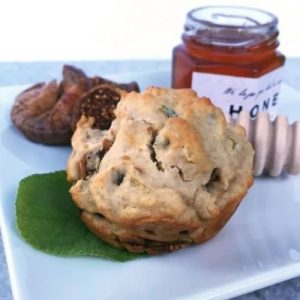
Easy Honey-Infused Fig Onion Muffins
A perfect balance of sweet figs, caramelized onions, and fragrant sage, these muffins are wholesome, flavorful, and easy to prepare. Ideal for breakfast, snacks, or a side for dinner, they are high in fiber, rich in natural flavors, and lightly sweetened with honey for a naturally satisfying bite.
Equipment
- 1 Small skillet
- 12-cup muffin pan
- Foil or paper muffin liners
- Wire cooling rack
- Mixing bowls (large and small)
- Rubber spatula
Ingredients
- 2 oz unsalted butter
- ½ cup yellow onion finely chopped
- ½ cup dried figs chopped
- 8 fresh sage leaves shredded
- 1¼ cups all-purpose flour
- ½ cup whole wheat flour
- 3 tsp baking powder
- ½ tsp salt
- 1 large egg
- 1 –2 tbsp honey
- 2 cups whole milk
Instructions
- Preheat and Prepare Muffin Pan: Begin by setting your oven to 400°F (200°C) to ensure it reaches the perfect baking temperature by the time your batter is ready. While the oven heats, prepare a 12-cup muffin pan. Lightly grease each cup with butter or cooking spray, or line them with paper or foil muffin liners. This step prevents sticking and ensures your muffins release easily after baking.
- Sauté the Onions: Place 2 ounces of unsalted butter in a small skillet over medium heat. Once the butter melts completely, add the finely chopped yellow onion. Gently cook the onions for 5 to 10 minutes, stirring frequently to avoid browning. The goal is to soften them until tender and aromatic, which enhances the natural sweetness without caramelizing too much.
- Combine Onions with Figs and Sage: Once the onions are tender, remove the skillet from the heat and allow them to cool slightly for a few minutes. Then, add the chopped dried figs and shredded sage leaves to the skillet. Stir gently to combine, letting the flavors meld. The figs add natural sweetness and chewy texture, while the sage provides an earthy, fragrant note that balances the muffin’s flavor.
- Mix Dry Ingredients Together: In a large mixing bowl, sift together the all-purpose flour, baking powder, and salt. Sifting ensures there are no lumps and creates a lighter, more tender muffin texture. Stir in the whole wheat flour until evenly distributed. This combination of flours adds both structure and fiber, giving the muffins a wholesome, hearty quality.
- Prepare Wet Ingredients: In a separate small bowl, crack and whisk one large egg until smooth. Gradually mix in the whole milk and honey, stirring until fully blended. The egg adds richness and protein, the milk provides moisture, and the honey contributes natural sweetness while enhancing the overall flavor profile.
- Incorporate Onion-Fig Mixture: Add the cooled onion, fig, and sage mixture into the wet ingredients. Stir gently to distribute the ingredients evenly throughout the liquid. This ensures that every muffin bite will contain balanced pockets of sweet figs, tender onions, and fragrant sage.
- Combine Wet and Dry Ingredients: Create a well in the center of the dry flour mixture. Pour the wet mixture, including the onions, figs, and sage, into the well. Using a rubber spatula, gently fold the ingredients together. Mix just until the flour is moistened—overmixing can result in tough muffins. Aim for a slightly lumpy but fully combined batter for the best texture.
- Fill Muffin Cups: Using a spoon or small ice cream scoop, evenly divide the batter among the prepared muffin cups. Fill each cup about ¾ full to allow space for the muffins to rise without overflowing. Smooth the tops slightly with the back of a spoon for even baking.
- Bake the Muffins: Place the muffin pan in the preheated oven and bake for 20–25 minutes. Check for doneness by inserting a toothpick into the center of a muffin; it should come out clean or with just a few crumbs attached. The muffins should have golden-brown peaks and a fragrant aroma when fully baked.
- Cool Muffins Properly: Once baked, remove the muffins from the oven and allow them to cool in the pan for 5 minutes. This brief rest helps them firm up and makes them easier to remove. Then, transfer the muffins to a wire rack to cool completely, preventing the bottoms from becoming soggy. Cooling also helps the flavors settle for the perfect taste and texture.
- Serve and Enjoy: These muffins are versatile and can be enjoyed warm or at room temperature. Serve them alongside a roasted chicken dinner, pair with creamy goat cheese for breakfast, or enjoy as a fiber-rich snack any time of day. Drizzle a little extra honey if desired for added sweetness.
Notes
- These muffins are a perfect balance of sweet figs and savory onions; do not overcook the onions to maintain a delicate flavor.
- Fresh sage adds a subtle earthy aroma, but you can experiment with thyme or rosemary for a different herbal twist.
- Use ripe, chewy dried figs for best texture; if figs are too dry, soak them briefly in warm water before chopping.
- Do not overmix the batter once wet and dry ingredients are combined, as this may make muffins dense rather than light and tender.
- Honey adds natural sweetness, but you can adjust the amount to suit your preference or swap for maple syrup.